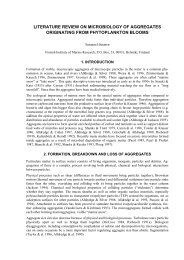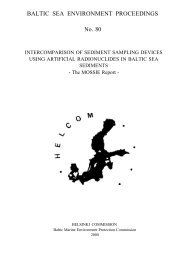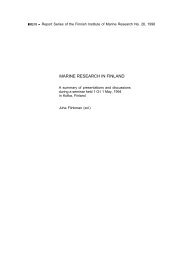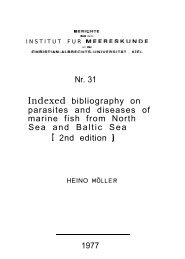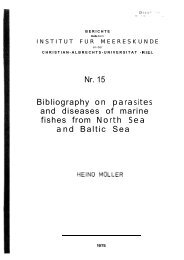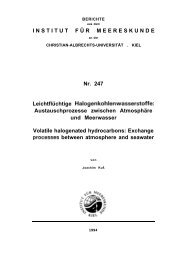the numerical sea ice forecast in finland in the winter 1993-94 ...
the numerical sea ice forecast in finland in the winter 1993-94 ...
the numerical sea ice forecast in finland in the winter 1993-94 ...
- No tags were found...
You also want an ePaper? Increase the reach of your titles
YUMPU automatically turns print PDFs into web optimized ePapers that Google loves.
19<br />
1<br />
ou•u, a tEp ort<br />
Fig. 6. The mentioned observation po<strong>in</strong>ts. The image area identifications are <strong>in</strong> rectangles.<br />
4. THE AUTOMATED SEA ICFJOPEN WATER DISCRIMINATION<br />
FROM ERS-1 SAR IMAGES<br />
The F<strong>in</strong>nish Institute of Mar<strong>in</strong>e Re<strong>sea</strong>rch participated dur<strong>in</strong>g <strong>the</strong> years <strong>1993</strong>- 19<strong>94</strong> <strong>in</strong> <strong>the</strong> Application<br />
Oriented Pilot Project accepted by ESA talled “Operational <strong>sea</strong> <strong>ice</strong> chart<strong>in</strong>g us<strong>in</strong>g ERS-1 SAR<br />
images” (OSIC). An important part of <strong>the</strong> project has been to <strong>in</strong>vestigate <strong>the</strong> possibilities to automate<br />
SAR image <strong>in</strong>terpretation. The first step <strong>in</strong> this direction has been to develop a classification<br />
algorithm to discrim<strong>in</strong>ate <strong>sea</strong> <strong>ice</strong> and open water from an ERS-1 SAR image. The algorithm has been<br />
exam<strong>in</strong>ed <strong>in</strong> detail <strong>in</strong> Similä (19<strong>94</strong>a) and more <strong>the</strong>oretically <strong>in</strong> Similä (19<strong>94</strong>b).<br />
The classification algorithm is based on <strong>the</strong> physical fatt that <strong>the</strong> correlation structure of <strong>the</strong><br />
backscatter is different for open water and <strong>ice</strong> fields. The open water pixels are practically<br />
uncorrelated whereas <strong>the</strong> <strong>ice</strong> field pixels are more or less strongly correlated <strong>in</strong> <strong>the</strong> Low Resolution<br />
images used with a resolution of 100 m by 100 m. Because <strong>the</strong> variance is big <strong>in</strong> <strong>the</strong> SAR images, <strong>the</strong><br />
identification of open water or <strong>ice</strong> with <strong>the</strong> aid of autocorrelation demands a quite large pixel block<br />
size. Accord<strong>in</strong>g to <strong>the</strong> experiments <strong>the</strong> pixel block size of 15 by 15 pixels was reliable enough for <strong>the</strong><br />
correlation calculations. For a pixel block of this size <strong>the</strong> directional autocorrelations to four<br />
directions were calculated and <strong>the</strong> mean autocorrelation was assigned as <strong>the</strong> correlation value of <strong>the</strong><br />
pixel block.<br />
If <strong>the</strong> correlation value was very low <strong>the</strong> pixel was assigned with certa<strong>in</strong>ty to <strong>the</strong> open water elass. On<br />
<strong>the</strong> o<strong>the</strong>r hand if <strong>the</strong> correlation value was high it was <strong>in</strong>terpreted to represent <strong>ice</strong> with a large<br />
probability. Because <strong>the</strong> threshold values to separate open water and <strong>ice</strong> classes can not be estimated<br />
from <strong>the</strong> image, <strong>the</strong>y are given <strong>in</strong> advance, rely<strong>in</strong>g on past experience. Hence, <strong>the</strong> threshold values are<br />
somewhat arbitrary and <strong>the</strong>re exists a relatively large range of correlation values where each elass is<br />
possible.<br />
Cluster<strong>in</strong>g <strong>the</strong> image accord<strong>in</strong>g to <strong>the</strong> correlation values produces a crude image segmentation with<br />
resolution of 1500 m by 1500 m. This result is improved with a pixelwise classification.




